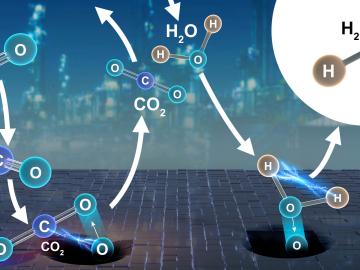
Filter News
Area of Research
- Advanced Manufacturing (5)
- Biology and Environment (30)
- Computational Biology (1)
- Computational Engineering (2)
- Computer Science (7)
- Energy Science (118)
- Energy Sciences (1)
- Fusion and Fission (18)
- Fusion Energy (9)
- Isotopes (7)
- Materials (66)
- Materials for Computing (9)
- National Security (18)
- Neutron Science (73)
- Nuclear Science and Technology (8)
- Sensors and Controls (1)
- Supercomputing (33)
- Transportation Systems (2)
News Type
News Topics
- (-) Artificial Intelligence (60)
- (-) Biomedical (41)
- (-) Composites (26)
- (-) Element Discovery (1)
- (-) Energy Storage (88)
- (-) Fusion (35)
- (-) Machine Learning (37)
- (-) Neutron Science (91)
- (-) Security (20)
- (-) Transportation (74)
- 3-D Printing/Advanced Manufacturing (95)
- Advanced Reactors (27)
- Big Data (37)
- Bioenergy (65)
- Biology (74)
- Biotechnology (21)
- Buildings (46)
- Chemical Sciences (57)
- Clean Water (23)
- Computer Science (119)
- Coronavirus (34)
- Critical Materials (25)
- Cybersecurity (26)
- Education (3)
- Emergency (1)
- Environment (126)
- Exascale Computing (17)
- Fossil Energy (2)
- Frontier (20)
- Grid (45)
- High-Performance Computing (55)
- Hydropower (8)
- Irradiation (2)
- Isotopes (38)
- ITER (6)
- Materials (105)
- Materials Science (105)
- Mathematics (8)
- Mercury (9)
- Microelectronics (1)
- Microscopy (39)
- Molten Salt (8)
- Nanotechnology (47)
- National Security (38)
- Nuclear Energy (63)
- Partnerships (35)
- Physics (46)
- Polymers (28)
- Quantum Computing (19)
- Quantum Science (48)
- Simulation (27)
- Space Exploration (13)
- Statistics (2)
- Summit (32)
Media Contacts

A team including Oak Ridge National Laboratory and University of Tennessee researchers demonstrated a novel 3D printing approach called Z-pinning that can increase the material’s strength and toughness by more than three and a half times compared to conventional additive manufacturing processes.

IDEMIA Identity & Security USA has licensed an advanced optical array developed at Oak Ridge National Laboratory. The portable technology can be used to help identify individuals in challenging outdoor conditions.

Oak Ridge National Laboratory is training next-generation cameras called dynamic vision sensors, or DVS, to interpret live information—a capability that has applications in robotics and could improve autonomous vehicle sensing.

Using additive manufacturing, scientists experimenting with tungsten at Oak Ridge National Laboratory hope to unlock new potential of the high-performance heat-transferring material used to protect components from the plasma inside a fusion reactor. Fusion requires hydrogen isotopes to reach millions of degrees.

Collaborators at the Department of Energy’s Oak Ridge National Laboratory and U.S. universities used neutron scattering and other advanced characterization techniques to study how a prominent catalyst enables the “water-gas shift” reaction to purify and generate hydrogen at industrial scale.

In Hong Wang’s world, nothing is beyond control. Before joining Oak Ridge National Laboratory as a senior distinguished researcher in transportation systems, he spent more than three decades studying the control of complex industrial systems in the United Kingdom.

Researchers at Oak Ridge National Laboratory are taking inspiration from neural networks to create computers that mimic the human brain—a quickly growing field known as neuromorphic computing.

A team of researchers at Oak Ridge National Laboratory have demonstrated that designed synthetic polymers can serve as a high-performance binding material for next-generation lithium-ion batteries.

Researchers have pioneered a new technique using pressure to manipulate magnetism in thin film materials used to enhance performance in electronic devices.

A study led by Oak Ridge National Laboratory explored the interface between the Department of Veterans Affairs’ healthcare data system and the data itself to detect the likelihood of errors and designed an auto-surveillance tool


